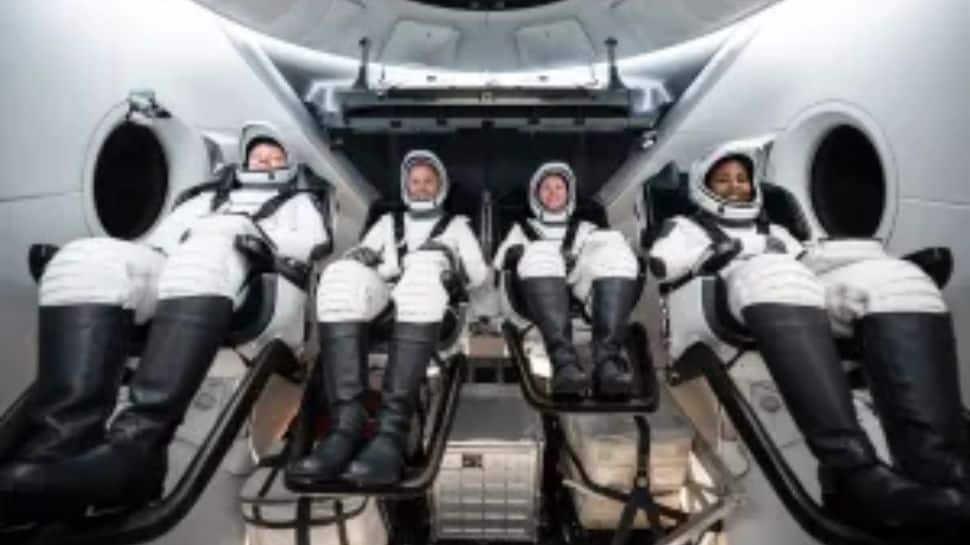NASA astronaut Nick Hague and Roscosmos cosmonaut Aleksandr Gorbunov are set to launch no earlier than Sept. 24 on the agency’s SpaceX Crew-9 mission to the International Space Station.
The crew update follows NASA’s decision to return Boeing’s crew flight test uncrewed and launch Crew-9 with two unoccupied seats. NASA astronauts Butch Wilmore and Suni Williams, who launched aboard the Starliner spacecraft in June, will fly home with Hague and Gorbunov in February 2025, according to a NASA news release.
NASA astronauts Zena Cardman and Stephanie Wilson, previously announced as crewmates, are eligible to be reassigned to a future mission. Hague and Gorbunov will fly to the space station as commander and mission specialist, respectively, as part of a two-person flight aboard a SpaceX Dragon spacecraft.
The decision to bring Hague on board was made by NASA’s chief astronaut, Joe Acaba, at the agency’s Johnson Space Center in Houston. Acaba had to strike a balance between having a NASA crew member with prior spaceflight experience command the flight while also ensuring NASA maintained an integrated crew with a Roscosmos cosmonaut who could operate its critical systems to ensure safe and continued station operations.
“While we have changed crews before for various reasons, reducing the crew size for this flight was another difficult decision to adjust to given that the crew has trained as a crew of four,” said Acaba.
“I have the utmost confidence in our entire crew, who have been excellent throughout training for the mission. Zena and Stephanie will continue to assist their crewmates prior to launch and exemplify what it means to be a professional astronaut.”
The agency will share details of Cardman and Wilson’s reassignment when they become available, the statement added. “I am deeply proud of our entire crew,” Cardman said, “and I am confident that Nick and Alex will assume their roles with excellence. The four of us remain dedicated to the success of this mission, and Stephanie and I look forward to flying when the time is right.”
Wilson added, “I know Nick and Alex will do a great job with their work aboard the International Space Station as part of Expedition 72.” With 203 days logged in space, this will be Hague’s third launch and second mission to the orbiting laboratory. During her first launch in October 2018, Hague and her crewmate, Alexey Ovchinin of Roscosmos, experienced a booster rocket failure, resulting in an in-flight, post-launch abort, ballistic re-entry and safe landing in their Soyuz MS-10 spacecraft.
Five months later, Hague launched aboard Soyuz MS-12 and served as a flight engineer aboard the space station during Expeditions 59 and 60. Hague performed three spacewalks to upgrade the space station’s power systems and install a docking adapter for commercial spacecraft.
Hague, an active-duty colonel in the U.S. Space Force, completed a development rotation with the Department of Defense and served as the Space Force’s director of test and evaluation from 2020 to 2022. In August 2022, Hague resumed his duties with NASA, working on the Boeing Starliner Program until this flight assignment.
This will be Gorbunov’s first trip to space and the station. Born in Zheleznogorsk, Kursk region, Russia, he studied engineering with degrees in spacecraft and upper stages at the Moscow Aviation Institute.
Gorbunov graduated from the military department with a specialty in operation and repair of aircraft, helicopters and aircraft engines. Prior to his selection as a cosmonaut in 2018, he worked as an engineer for Rocket Space Corp. Energia and supported cargo spacecraft launches from the Baikonur Cosmodrome, the statement added.
Hague and Gorbonov will become members of the Expedition 72 crew aboard the station. They will join Wilmore, Williams, fellow NASA astronaut Don Pettit and Roscosmos cosmonauts Alexey Ovchinin and Ivan Vagner, who will conduct scientific research and maintenance activities during the 24th year of continuous human presence on the station.
Disclaimer:
The information contained in this post is for general information purposes only. We make no representations or warranties of any kind, express or implied, about the completeness, accuracy, reliability, suitability or availability with respect to the website or the information, products, services, or related graphics contained on the post for any purpose.
We respect the intellectual property rights of content creators. If you are the owner of any material featured on our website and have concerns about its use, please contact us. We are committed to addressing any copyright issues promptly and will remove any material within 2 days of receiving a request from the rightful owner.

